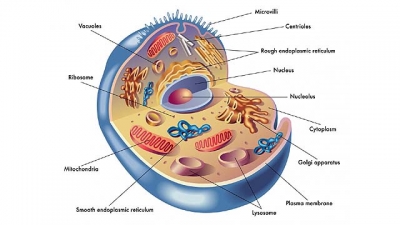
The body is made of trillions of cells, each too small to see without a microscope. These cells aren’t all the same. There are about 200 different types, each with its own size, shape, and contents. Each type of cell has a particular task.
Just as the body has organs, such as the heart, the cell has organelles, such as mitochondria. These parts work together to make the cell a living unit. In addition, tiny rods, including microtubes, move organelles and form a kind of “skeleton” that supports and shapes the cell.
Golgi apparatus
The Golgi apparatus processes and packages proteins made on ribosomes, ready for use inside or outside the cell.
Vesicle
This bag takes proteins from the Golgi apparatus and carries them to where they are needed.
Cell membrane
This flexible membrane surrounds the cell and controls what enters and exist. It consists of a double layer of lipid (fat) molecules containing proteins that have different jobs to do.
- Lipid layer: A double layer of lipid (fat) molecules forms main part of the membrane.
- Protein: This protein channel transports substances into and out of the cell.
- Glycoprotein: This “tag” identifies the cell to other cells.
Centrioles
These two bunches of microtubles play a key part in cell division.
ATP synthase
This is where the energy-carrier ATP is made.
Microvilli
These structures increase the area of a cell’s surface so it is better at taking in substances nut not all cells have them.
Rough endoplasmic reticulum
This network of tubes and flattened bags makes and transports proteins and other substances.
Ribosome
This tiny structure makes the many proteins that build and run the cell.
Nucleus
This tiny structure makes the many proteins that build and run the cell.
Lysosome
This membrane bag contains enzymes that break down unwanted substances and recycle worn-out organelles.
Cytoplasm
A jelly-like fluid in which organelles floats, the cytoplasm contains proteins and other substances.
Microtubes
These structures help to shape the cell and move organelles.
Vacuole
This bag contains water and food taken into the cell.
Mitochondria
These sausage-shaped organelles are the cell’s power stations. They release the energy from glucose and other foods that cells use to drive their many activities.
Inner membrane
A folded membrane provides a large surface for making ATP.
Cell structure
No cell is exactly like the one shown here, but this example shows the features that are found in many body cells. Each busy, living cell consists of an outer membrane, cytoplasm, and different types of organelles. Most cells have a control centre called the nucleus.
Picture Credit : Google

